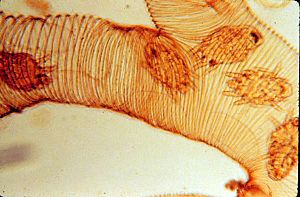Acarapis woodi facts for kids
Quick facts for kids Acarapis woodi |
|
|---|---|
 |
|
| Scientific classification |
Acarapis woodi is a tiny parasite that lives inside honey bees. These mites were first noticed causing problems on the Isle of Wight in 1904. However, scientists didn't officially describe them until 1921.
Acarapis woodi mites live and have their babies inside the breathing tubes, called tracheae, of bees. When bees are infested with these mites, beekeepers used to call it the Isle of Wight Disease. Now, it's known as Acarine disease. This name comes from the group of animals, called Subclass Acarina, that these mites belong to. All mites are arachnids, just like spiders.
About Acarapis woodi Mites
Acarapis woodi mites are very small. They are usually less than 175 micrometers long. This means you can only see and identify them using a microscope.
How They Affect Bees
These mites are harmful to bees. They prefer to attack young bees, usually those up to two weeks old. The mites enter the bee's breathing tubes through tiny openings. Once inside, they use their mouthparts to poke holes in the walls of the breathing tubes. Then, they feed on the bee's "blood," which is called haemolymph.
When many mites live in a bee's breathing tubes, it can really weaken the bee. More than a hundred mites can live inside one bee's tracheae. This makes it hard for the bee to breathe and fly properly.
Life Cycle of the Mite
The female Acarapis woodi mite lays about 5 to 7 eggs. She attaches these eggs to the inside walls of the bee's breathing tubes. The eggs hatch into larvae, which are like baby mites. These larvae then grow and develop into adult mites. This whole process, from egg to adult, takes about 11 to 15 days.
Similar Mites
There are other mites that look similar to Acarapis woodi. These include Acarapis externus and Acarapis dorsalis.

